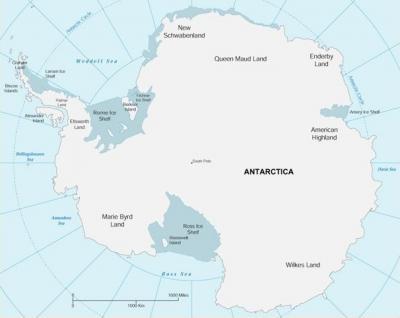As the national repository for geological material from the Southern Ocean, the Antarctic Marine Geology Research Facility at Florida State University houses the premier collection of Antarctic sediment cores -- and a hot new acquisition will offer an international team of scientists meeting there May 1-4 its best look yet at the impact of global warming on oceans worldwide.
The remarkable new core was extracted during the recent Antarctic summer from record-setting drilling depths 4,214 feet below the sea floor beneath Antarctica's Ross Ice Shelf, the Earth's largest floating ice body. Laced with sediment dating from the present day to about 10 million years ago, the core provides a geologic record of the ice shelf's history in unprecedented detail.
In fact, a polar research news feature in the March 2007 edition of the journal Nature called the sediment core "a frozen time capsule from Earth's icy past."
Greenish rock layered throughout the "time capsule" indicates periods of open-water conditions, suggesting that the Ross ice shelf retreated and advanced perhaps as many as 50 times over the last 5 million years in response to climate changes, says FSU AMGRF Head Curator Matthew Olney. He notes that signs of fluctuations such as these are critical because the Ross Sea ice is a floating extension of the even bigger West Antarctic Ice Sheet -- an area of the southernmost continent so unstable that scientists foresee its collapse in a world overheated by global warming. Map of Antarctica. Credit: Courtesy of the Antarctic Marine Geology Research Facility at FSU
Map of Antarctica. Credit: Courtesy of the Antarctic Marine Geology Research Facility at FSU
Credit for the core's record-setting extraction goes to the inaugural expedition of ANDRILL (ANtarctic geological DRILLing) -- a $30 million multinational project for which FSU is playing the key curatorial role. The collaborative research initiative is the most ambitious seafloor drilling effort ever undertaken at the Antarctic margins.
May 1-4, members of FSU's geology faculty and AMGRF staff will welcome to campus more than 100 ANDRILL researchers -- scientists, drillers, students and educators from Germany, Italy, New Zealand and the United States -- for the first post-drilling meeting.
"The upcoming ANDRILL workshop at FSU will focus on the review and completion of an initial report on the first ANDRILL expedition as well as giving the scientists an opportunity to re-examine the cores now safely stored at the AMGRF," Olney said.
FSU's ANDRILL role kicked off in December when university staff, undergraduates Charlie King and Kelly Jemison, graduate student Steve Petrushack, visiting research associate Davide Persico, AMGRF Head Curator Matthew Olney and Assistant Curator Matthew Curren began a three-month stint on the curatorial team. Only one member of the team had previously been to Antarctica.
Their curatorial duties included transporting sediment core sections seven miles from the drill site to the McMurdo Station laboratory; splitting them longitudinally into working and archive halves, then imaging each split face; taking samples from the working half for on-ice scientific description; and safely packing, logging and transporting them back to the FSU research facility.
Wise pointed out that the recent ANDRILL expedition to Antarctica was the second such project involving AMGRF scientists, curators, and students within a six-month period -- the first being the SHALDRIL ("Shallow Drilling") cruise in which FSU took a leadership role. "It's been a very busy year at our facility, with six FSU participants on both projects involved in the science to various degrees while providing curatorial support to both," he added.
FSU and its ANDRILL partners already are gearing up for the next excursion, scheduled for October 2007 during the Antarctic spring. Still, the inaugural trip was especially memorable.
"So many scientists and technicians brought together from around the world for the first time and under taxing conditions made for a challenging work environment," Olney said. "Yet, the entire ANDRILL team did a superb job with one aim in mind: recovering a record-breaking geological record that will remain a legacy to the scientific community for decades to come."
Source: Florida State University.